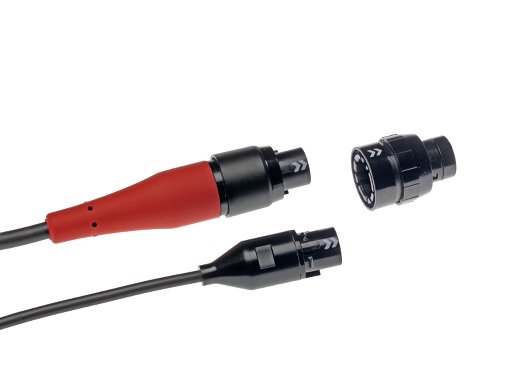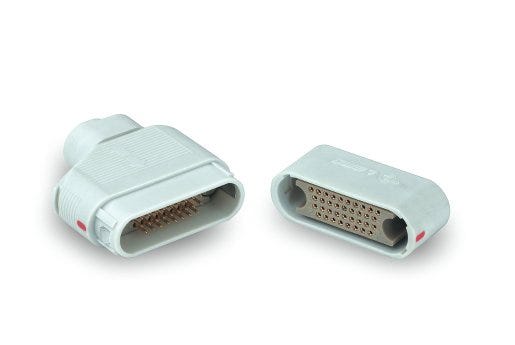Electronic connector solutions used in consumer and industrial applications are slowly but surely making their way into medical devices.
June 22, 2016

Frank Vinluan
The MediSpec Medical Plastic Circular Interconnect System from Molex provides an alternative to typical medical circular connectors in a custom-off-the-shelf design. |
The miniaturization of medical devices brings benefits to clinicians and patients. Smaller, sleeker devices are easier for physicians to hold and maneuver. For patients, a smaller device can offer less discomfort. But many of these products still connect to cables. As devices get smaller and narrower, all the while being tasked with carrying more complex electronics that transmit more data, connector suppliers must find ways to provide greater functionality within a shrinking footprint.
In the past, off-the-shelf connectors were often sufficient to meet requirements for medical devices, said Anthony Kalaijakis, strategic medical marketing manager at Lisle, IL-based Molex. As products became more specialized, Molex addressed OEM needs by producing custom connectors. These days, it's more common for medical device makers to ask for connectors that can work in devices that are smaller, lighter, and even have wireless capabilities. This trend has led Molex to tap the work it has done in other industries.
[See Molex at booth #1949 at the MD&M Minneapolis expo, September 21-22, 2016]
Consumer electronics have long been on track toward smaller devices that require smaller connectors, Kalaijakis said. That trend accelerated with the emergence of mobile electronics. Innovations that paved the way for smaller products in consumer and industrial applications have carried over to medical devices. While medical devices have started to incorporate some of these smaller connectors, regulations covering medical devices mean this adoption moves more slowly, Kalaijakis explained. Still, electronic circuits used in mobile phones are finding applications in medical devices that have wireless capabilities, while fiber optic technologies used in telecommunications equipment finds applications in medical robotics, Kalaijakis said.
|
A Lemo R Connector, a rectangular self-latching connector with a plastic shell, can be used in applications such as dental equipment. |
Lemo USA is also seeing more OEM requests for connectors used in fiber optic applications, although the miniaturization trend in medtech is less of a concern at the Rohnert Park, CA-based company. Most of Lemo's connectors are outside of the device, so the main considerations are the ease of pushing and pulling to mate and unmate a cable and the ability of the connector to reliably maintain the connection, said applications engineer Randy Jew. Another requirement Lemo sees with greater frequency is greater density in the connectors. OEMs may want connectors of the same size, but they now want those connectors to hold more pins, which presents challenges, Jew explained.
Lemo can sometimes draw on connector solutions from other industries, but not always. For example, the military is one of the markets the company. Like medical devices, military applications are technically demanding and call for high performance. But medical OEMs prize ease of mating and unmating of connectors, a feature the military does not want for its connectors, Jew explained.
As devices get smaller, it's harder to ensure that the electronic components can perform at the same level. Size isn't the only challenge. Unlike industrial applications or consumer electronics, medical device components must satisfy additional standards. When adapting connector technology developed for a nonmedical application for use in a medical device, that connector must meet sterilization requirements, Kalaijakis explained. If the device is an implantable product, the connector must be made from implantable-grade material.
Increasingly, connector companies also must consider how a device will be handled by someone who is not a clinician. As devices become portable and are used outside of medical settings, OEMs and connector companies need to think about how easily it can be handled by a home healthcare worker or even by a patient.
"Yes, we can make it tiny," Kalaijakis said. "But how is a 70-year-old patient able to manipulate it?"
There are stark differences between the way large companies and startups approach the supplier process. In many cases, large companies have people working on the same project from different locations, Jew said. That makes communication and coordination more difficult and can lengthen the time needed to select a connector. With startups, the process can be faster.
"Startups are very focused," Jew said. "They can tell you whether they have the time or they have the money."
Dialogue between Molex and a medical device maker can vary, depending on the size of the company and the nature of the relationship. Sometimes Molex works directly with the OEM, and other times, its interaction is with an EMS subcontractor.
In order to smooth the process of connector selection, it's important for OEMs to have details about the product, such as the level of compliance required, Kalaijakis said. OEMs should also be clear about their expectations, such as the time to market and the price points they have in mind. Catching those details up front helps prevent problems that can hold up a medical device later on.
"You want to make sure you get things sorted out on the front end," Kalaijakis said.
Price plays a major role in connector selection, too. Whereas the military will pay for high-performance connectors, medical device makers typically operate on tighter budgets, Jew said. The OEM's budget helps the supplier determine how to address their requirements. A custom connector is always possible, but that choice depends on how much time the OEM has and how much money it is willing to spend, Jew said. If the company does not want to spend more for a custom connector, Lemo will look at catalog products or find ways to make smaller modifications.
It's one matter to address the technical requirements asked of connectors and another to address the business requirements. Cost is a matter of the cost per unit, which in turn depends on how many connectors an OEM wants to make. The supplier needs to know the technical and the cost requirements in order to proceed with design work, Jew said.
"They go hand in hand, the technical and the business part," he said. "There has to be a good business case for a new technology or a new way to go with a connector."
Frank Vinluan is a frequent contributor to MD+DI. Reach him at [email protected].
[images courtesy of MOLEX and LEMO USA]
You May Also Like



